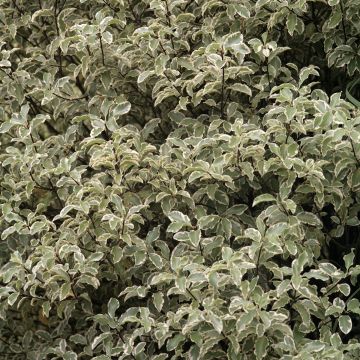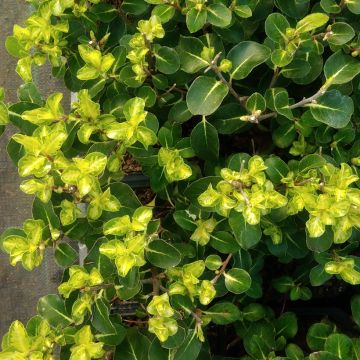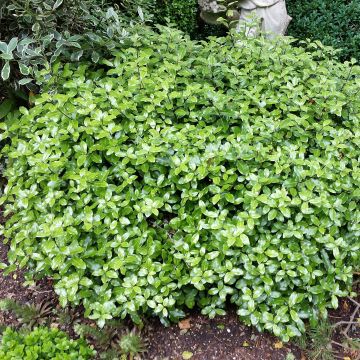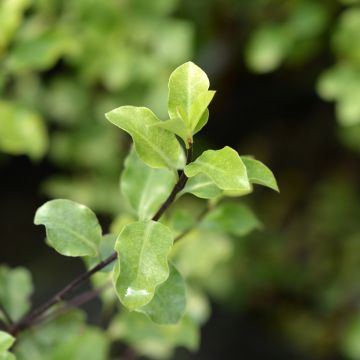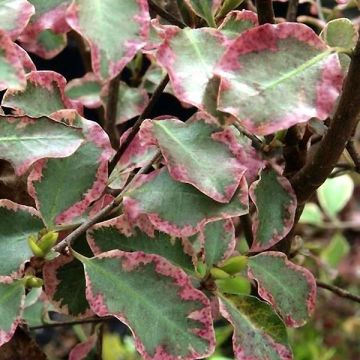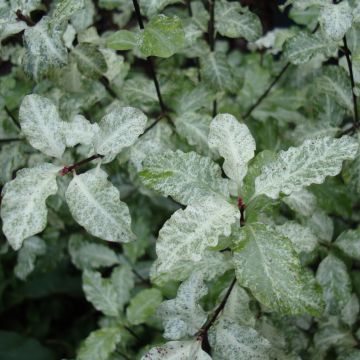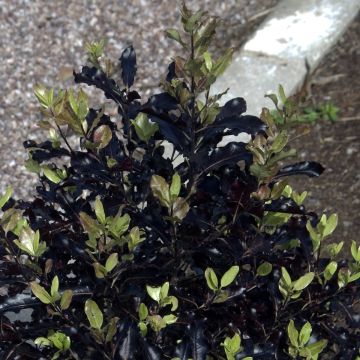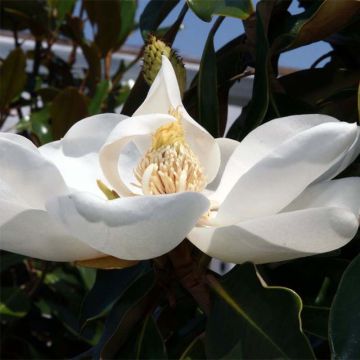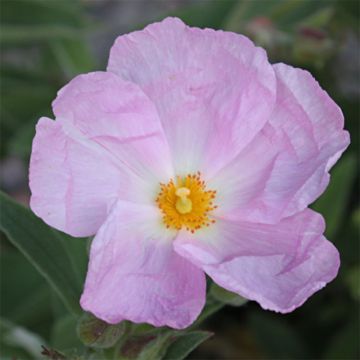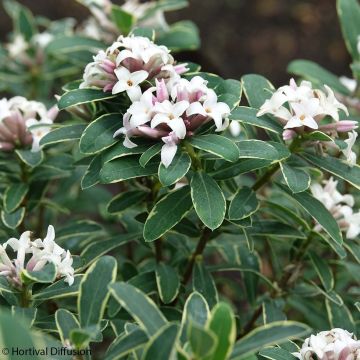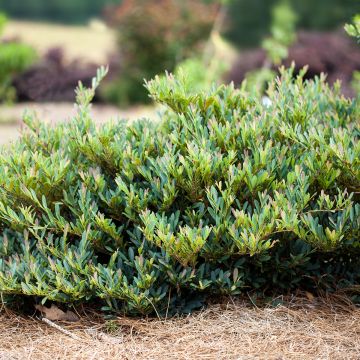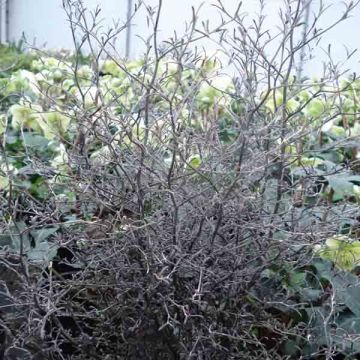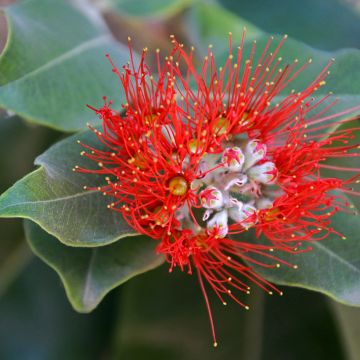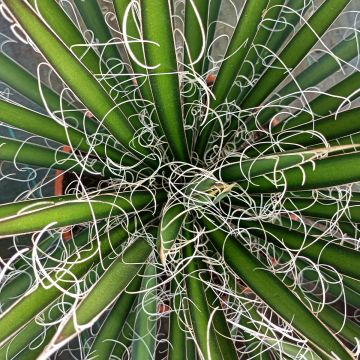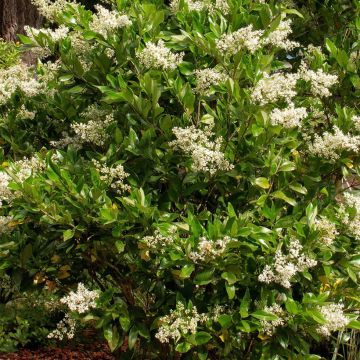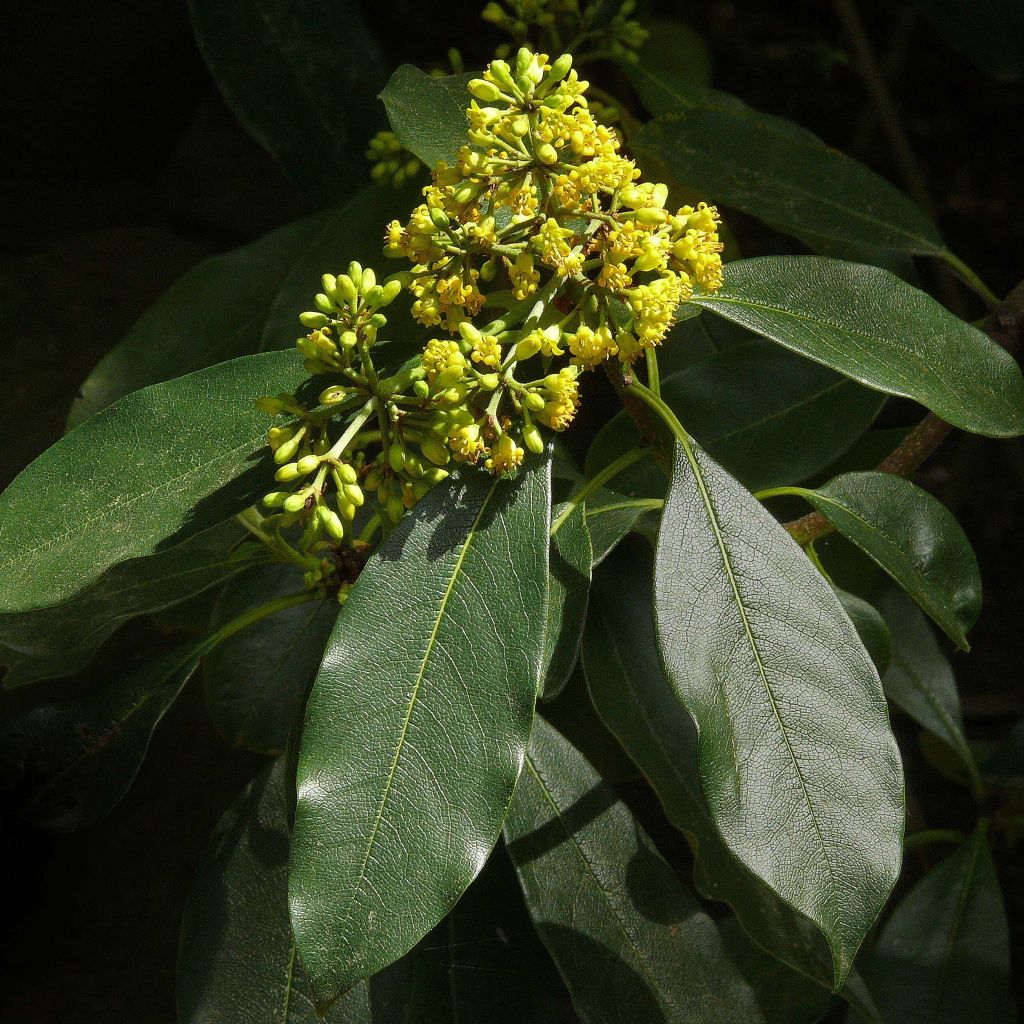

Pittosporum daphniphylloides
Pittosporum daphniphylloides
Pittosporum daphniphylloides
Beautiful specimen, well-rooted and ramified. Very good health condition. Dark green foliage for the older leaves and light green for the new ones. Planting upon receipt in a prominent location to enjoy its fragrance. Waiting for it to take root and for the next scented flowering.
Nathalie, 29/04/2021
This plant carries a 24 months recovery warranty
More information
We guarantee the quality of our plants for a full growing cycle, and will replace at our expense any plant that fails to recover under normal climatic and planting conditions.
From €5.90 for pickup delivery and €6.90 for home delivery
Express home delivery from €8.90.

Does this plant fit my garden?
Set up your Plantfit profile →
Description
Pittosporum daphniphylloides can be grown in the ground almost anywhere. This superb Asian species will seduce gardeners with its small tree-like appearance, its elegant evergreen foliage made up of large glossy leaves with a bluish sheen, as well as its pale yellow spring flowers in pleasantly fragrant clusters. Give this beautiful shrub a prime spot, perhaps at the end of a path. It will thrive in morning sun or partial shade, in well-drained garden soil that remains slightly moist in summer.
Pittosporum daphniphylloides is an evergreen shrub of the Pittosporaceae family, native to China and Taiwan. It can be found there in forests, thickets, rocky and sunny areas, deep valleys and on the slopes of hills, at altitudes ranging from 500 to 2500 m (1640 to 8202ft). Over time, it forms a small tree reaching a height of 2.75 m (9ft) with a spread of 2 m (7ft) in our climates, or more in fertile soil and milder climates. The young branches are bare and dotted with small nodules. The oldest branches are reddish-brown in colour. The leaves of this pittosporum are evergreen. They are clustered at the ends of the branches and carried by short petioles. The colour of the leaf, which is thick and leathery in texture, is a beautiful glossy green-blue on top, lighter underneath. The shape of the leaves is ovate to ovate-lanceolate, each measuring 10 to 23 cm (4 to 9in) in length and 4 to 8 cm (2 to 3in) in width.
Flowering takes place in May-June, earlier or later depending on the climate. It takes the form of small clusters or umbels measuring 4 to 6 cm (2in) in diameter, slightly hairy, composed of 3 to 7 small pale yellow flowers. These softly scented inflorescences open at the ends of the branches, as well as in the axils of the large leaves. After pollination by pollinating insects, fruits are formed that resemble round capsules measuring 6 to 10 mm (1in) in diameter, containing 10 to 23 seeds, initially red, turning black when ripe.
Hardy in well-drained soil and sheltered from the wind, Pittosporum daphniphylloides may be the hardiest of the genus. It is also one of the most ornamental, with its resemblance to a small Japanese medlar. Like the medlar, it can be acclimatised in most regions by carefully choosing its location. It can be placed in isolation or in a large shrub bed, preferably in a partially shaded position. To accompany it, consider planting, Daphniphyllums that resemble it, shrubs Buddleja delavayi or the astonishing Alchornea davidii. Unlike its famous Japanese relative Pittosporum tobira, it is not a coastal plant. According to American gardeners, this shrub, whose requirements are still little known seems to appreciate soils that do not dry out too much in summer.
Report an error about the product description
Pittosporum daphniphylloides in pictures
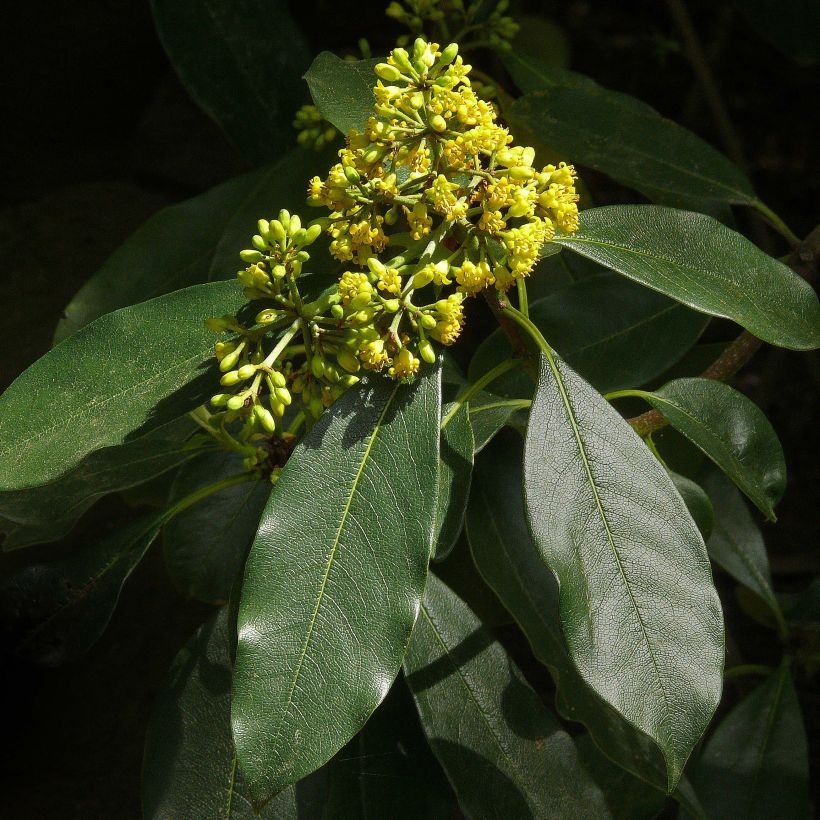

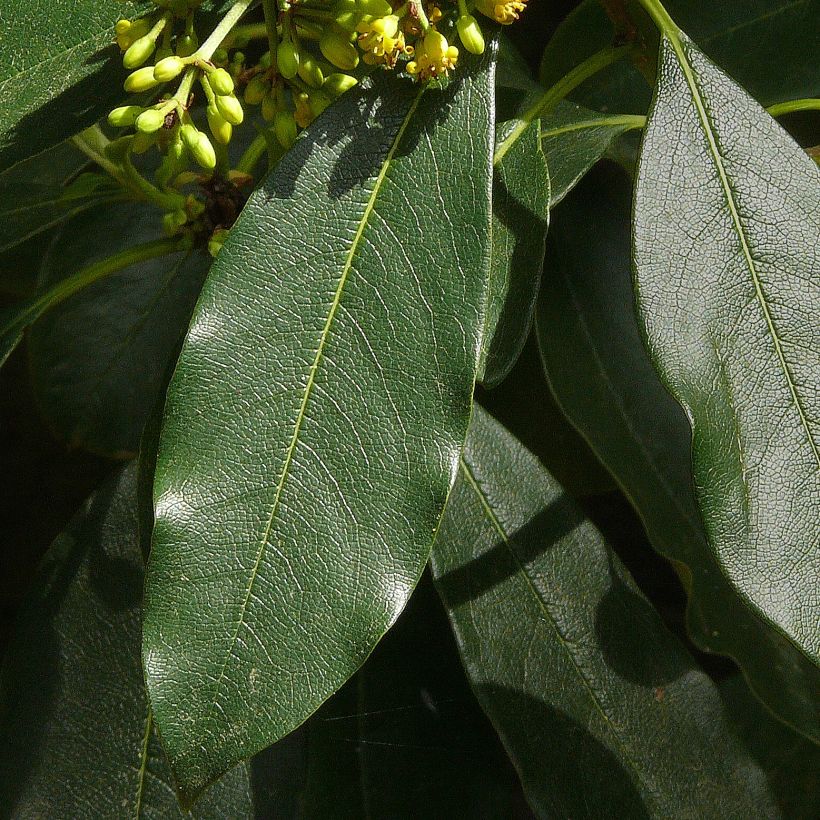

Plant habit
Flowering
Foliage
Botanical data
Pittosporum
daphniphylloides
Pittosporaceae
China
Other Pittosporum
Planting and care
Pittosporum daphniphylloides should preferably be planted in spring in cold climates, or in September-October in mild climates. It will withstand short frosts of at least -15°C (5°F), if sheltered from prevailing winds. Plant it along a south-facing wall in regions with very cold winters, as a precaution. Also choose a position away from the scorching sun, such as a spot in the morning sun or in partial shade. This shrub does not appreciate dry soils, it prefers soils that remain slightly moist in summer. In warm regions, it should even grow and flower well in the shade.
Plant it in well-drained garden soil, not too chalky, with shelter from prevailing winds. Its roots dislke waterlogged soils in winter. When planting, mix leaf compost and coarse sand into your garden soil at a ratio of 33%. Water well once or twice a week, as well as in case of prolonged drought, even when it is mature. Also mulch the soil in summer to maintain a certain level of moisture.
Planting period
Intended location
Care
-
, onOrder confirmed
Reply from on Promesse de fleurs
Evergreen shrubs
Haven't found what you were looking for?
Hardiness is the lowest winter temperature a plant can endure without suffering serious damage or even dying. However, hardiness is affected by location (a sheltered area, such as a patio), protection (winter cover) and soil type (hardiness is improved by well-drained soil).

Photo Sharing Terms & Conditions
In order to encourage gardeners to interact and share their experiences, Promesse de fleurs offers various media enabling content to be uploaded onto its Site - in particular via the ‘Photo sharing’ module.
The User agrees to refrain from:
- Posting any content that is illegal, prejudicial, insulting, racist, inciteful to hatred, revisionist, contrary to public decency, that infringes on privacy or on the privacy rights of third parties, in particular the publicity rights of persons and goods, intellectual property rights, or the right to privacy.
- Submitting content on behalf of a third party;
- Impersonate the identity of a third party and/or publish any personal information about a third party;
In general, the User undertakes to refrain from any unethical behaviour.
All Content (in particular text, comments, files, images, photos, videos, creative works, etc.), which may be subject to property or intellectual property rights, image or other private rights, shall remain the property of the User, subject to the limited rights granted by the terms of the licence granted by Promesse de fleurs as stated below. Users are at liberty to publish or not to publish such Content on the Site, notably via the ‘Photo Sharing’ facility, and accept that this Content shall be made public and freely accessible, notably on the Internet.
Users further acknowledge, undertake to have ,and guarantee that they hold all necessary rights and permissions to publish such material on the Site, in particular with regard to the legislation in force pertaining to any privacy, property, intellectual property, image, or contractual rights, or rights of any other nature. By publishing such Content on the Site, Users acknowledge accepting full liability as publishers of the Content within the meaning of the law, and grant Promesse de fleurs, free of charge, an inclusive, worldwide licence for the said Content for the entire duration of its publication, including all reproduction, representation, up/downloading, displaying, performing, transmission, and storage rights.
Users also grant permission for their name to be linked to the Content and accept that this link may not always be made available.
By engaging in posting material, Users consent to their Content becoming automatically accessible on the Internet, in particular on other sites and/or blogs and/or web pages of the Promesse de fleurs site, including in particular social pages and the Promesse de fleurs catalogue.
Users may secure the removal of entrusted content free of charge by issuing a simple request via our contact form.
The flowering period indicated on our website applies to countries and regions located in USDA zone 8 (France, the United Kingdom, Ireland, the Netherlands, etc.)
It will vary according to where you live:
- In zones 9 to 10 (Italy, Spain, Greece, etc.), flowering will occur about 2 to 4 weeks earlier.
- In zones 6 to 7 (Germany, Poland, Slovenia, and lower mountainous regions), flowering will be delayed by 2 to 3 weeks.
- In zone 5 (Central Europe, Scandinavia), blooming will be delayed by 3 to 5 weeks.
In temperate climates, pruning of spring-flowering shrubs (forsythia, spireas, etc.) should be done just after flowering.
Pruning of summer-flowering shrubs (Indian Lilac, Perovskia, etc.) can be done in winter or spring.
In cold regions as well as with frost-sensitive plants, avoid pruning too early when severe frosts may still occur.
The planting period indicated on our website applies to countries and regions located in USDA zone 8 (France, United Kingdom, Ireland, Netherlands).
It will vary according to where you live:
- In Mediterranean zones (Marseille, Madrid, Milan, etc.), autumn and winter are the best planting periods.
- In continental zones (Strasbourg, Munich, Vienna, etc.), delay planting by 2 to 3 weeks in spring and bring it forward by 2 to 4 weeks in autumn.
- In mountainous regions (the Alps, Pyrenees, Carpathians, etc.), it is best to plant in late spring (May-June) or late summer (August-September).
The harvesting period indicated on our website applies to countries and regions in USDA zone 8 (France, England, Ireland, the Netherlands).
In colder areas (Scandinavia, Poland, Austria...) fruit and vegetable harvests are likely to be delayed by 3-4 weeks.
In warmer areas (Italy, Spain, Greece, etc.), harvesting will probably take place earlier, depending on weather conditions.
The sowing periods indicated on our website apply to countries and regions within USDA Zone 8 (France, UK, Ireland, Netherlands).
In colder areas (Scandinavia, Poland, Austria...), delay any outdoor sowing by 3-4 weeks, or sow under glass.
In warmer climes (Italy, Spain, Greece, etc.), bring outdoor sowing forward by a few weeks.

































